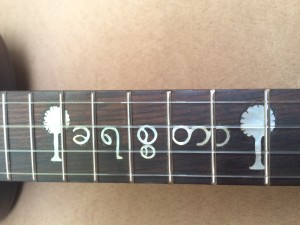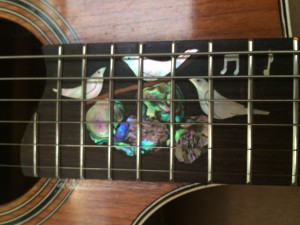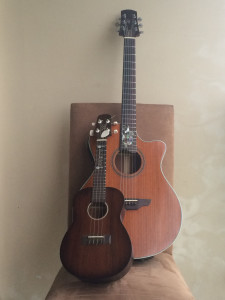My wife was looking to acquire a ukulele for some time when she was referred to a local luthier named Ko Cho (rumoured to be one of Yangon’s best kept secrets) who was known to use a variety of unique Myanmar woods for his materials. This sounded interesting and since I’ve been known to strum the guitar, I was interested to tag along with her to meet Ko Cho and talk strings.
On arrival to his home out near 16 mile on the outskirts of Yangon, Ko Cho immediately engaged with us and made us feel welcome like we’d known him for years. It was not long before we were inspecting works-in-progress and trying out finished-goods, learning about the different woods he uses, hearing about his time travelling the world as a merchant seaman, how he taught himself to make guitars from books and from writing to other luthiers, discussing our favourite musicians, his many cats and dogs, how he loves to cook and that he constantly thinks about his craft every minute of the day, even when he’s sleeping.

One of these two guitars (he hadn’t decided which yet) allegedly was commissioned for someone very well known in Myanmar on account of her being a fan of Ko Cho’s father, U Tint Aung who is best known as a musician, composer and writer, but also as a pioneering filmmaker and theatre director in Myanmar.
Time just flew by, but of most interest was when Ko Cho explained more about how he sources all his materials from naturally felled local tone wood trees, which we realized made his instruments uniquely Myanmar. Through years of experimentation he discovered the way to treat and work with woods such as mahogany, teak, rosewood, cedar and local jackfruit to name a few, that tonally work really well together. He also managed to salvage an array of timber felled during Cyclone Nargis in 2008 which he dried and now uses to make special guitars in remembrance of the many people – and trees – that perished in the devastation.
Eventually she decided she wanted a baritone mahogany ukulele (from Nargis wood), and I couldn’t help myself and settled on a cedar-mahogany, semi-acoustic guitar with some rosewood and teak for good measure.
The next thing to decide was whether we’d like a mother-of-pearl inlay design on the frets of our instruments which Ko Cho said he would happily design. This was an opportunity for us to really make our instruments even more unique, especially with more local natural materials.
With our design ideas, Ko Cho came up with the following:

Christa’s design – her name in Burmese with the Toddy Palm each side (one of the tragic losses of trees in Yangon during Nargis which she remembers used to be abundant in Yangon)

Matt’s design – birds emitting tunes on a tree branch, which reminds me of the Myanmar people’s love for singing.
And, the finished products:
It has been an absolute pleasure meeting Ko Cho, who we now know as a good friend. His passion, warmth and peaceful spirit is truly contagious.
We are humbled to now own these beautiful, uniquely Myanmar musical instruments. The workmanship, materials and pride with which they were made, make them truly, Earth’s Gifts.
You can find Ko Cho on maungnyocat@gmail.com
Contributed by Matt O’Kane

The day we picked up Christa’s ukulele – meeting Ko Cho’s parents U Tint Aung & Daw Khin Yi, and sharing afternoon tea in their home was a delight. You can see he still plays a mean mandolin! (which was made especially for him by Ko Cho of course 😉

